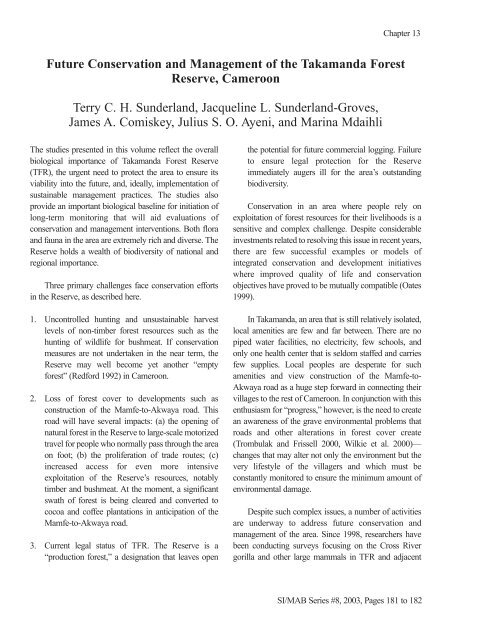Fisheries in the Southern Border Zone of Takamanda - Impact ...
Fisheries in the Southern Border Zone of Takamanda - Impact ...
Fisheries in the Southern Border Zone of Takamanda - Impact ...
Create successful ePaper yourself
Turn your PDF publications into a flip-book with our unique Google optimized e-Paper software.
Future Conservation and Management <strong>of</strong> <strong>the</strong> <strong>Takamanda</strong> Forest<br />
Reserve, Cameroon<br />
Terry C. H. Sunderland, Jacquel<strong>in</strong>e L. Sunderland-Groves,<br />
James A. Comiskey, Julius S. O. Ayeni, and Mar<strong>in</strong>a Mdaihli<br />
The studies presented <strong>in</strong> this volume reflect <strong>the</strong> overall<br />
biological importance <strong>of</strong> <strong>Takamanda</strong> Forest Reserve<br />
(TFR), <strong>the</strong> urgent need to protect <strong>the</strong> area to ensure its<br />
viability <strong>in</strong>to <strong>the</strong> future, and, ideally, implementation <strong>of</strong><br />
susta<strong>in</strong>able management practices. The studies also<br />
provide an important biological basel<strong>in</strong>e for <strong>in</strong>itiation <strong>of</strong><br />
long-term monitor<strong>in</strong>g that will aid evaluations <strong>of</strong><br />
conservation and management <strong>in</strong>terventions. Both flora<br />
and fauna <strong>in</strong> <strong>the</strong> area are extremely rich and diverse. The<br />
Reserve holds a wealth <strong>of</strong> biodiversity <strong>of</strong> national and<br />
regional importance.<br />
Three primary challenges face conservation efforts<br />
<strong>in</strong> <strong>the</strong> Reserve, as described here.<br />
1. Uncontrolled hunt<strong>in</strong>g and unsusta<strong>in</strong>able harvest<br />
levels <strong>of</strong> non-timber forest resources such as <strong>the</strong><br />
hunt<strong>in</strong>g <strong>of</strong> wildlife for bushmeat. If conservation<br />
measures are not undertaken <strong>in</strong> <strong>the</strong> near term, <strong>the</strong><br />
Reserve may well become yet ano<strong>the</strong>r “empty<br />
forest” (Redford 1992) <strong>in</strong> Cameroon.<br />
2. Loss <strong>of</strong> forest cover to developments such as<br />
construction <strong>of</strong> <strong>the</strong> Mamfe-to-Akwaya road. This<br />
road will have several impacts: (a) <strong>the</strong> open<strong>in</strong>g <strong>of</strong><br />
natural forest <strong>in</strong> <strong>the</strong> Reserve to large-scale motorized<br />
travel for people who normally pass through <strong>the</strong> area<br />
on foot; (b) <strong>the</strong> proliferation <strong>of</strong> trade routes; (c)<br />
<strong>in</strong>creased access for even more <strong>in</strong>tensive<br />
exploitation <strong>of</strong> <strong>the</strong> Reserve’s resources, notably<br />
timber and bushmeat. At <strong>the</strong> moment, a significant<br />
swath <strong>of</strong> forest is be<strong>in</strong>g cleared and converted to<br />
cocoa and c<strong>of</strong>fee plantations <strong>in</strong> anticipation <strong>of</strong> <strong>the</strong><br />
Mamfe-to-Akwaya road.<br />
3. Current legal status <strong>of</strong> TFR. The Reserve is a<br />
“production forest,” a designation that leaves open<br />
Chapter 13<br />
<strong>the</strong> potential for future commercial logg<strong>in</strong>g. Failure<br />
to ensure legal protection for <strong>the</strong> Reserve<br />
immediately augers ill for <strong>the</strong> area’s outstand<strong>in</strong>g<br />
biodiversity.<br />
Conservation <strong>in</strong> an area where people rely on<br />
exploitation <strong>of</strong> forest resources for <strong>the</strong>ir livelihoods is a<br />
sensitive and complex challenge. Despite considerable<br />
<strong>in</strong>vestments related to resolv<strong>in</strong>g this issue <strong>in</strong> recent years,<br />
<strong>the</strong>re are few successful examples or models <strong>of</strong><br />
<strong>in</strong>tegrated conservation and development <strong>in</strong>itiatives<br />
where improved quality <strong>of</strong> life and conservation<br />
objectives have proved to be mutually compatible (Oates<br />
1999).<br />
In <strong>Takamanda</strong>, an area that is still relatively isolated,<br />
local amenities are few and far between. There are no<br />
piped water facilities, no electricity, few schools, and<br />
only one health center that is seldom staffed and carries<br />
few supplies. Local peoples are desperate for such<br />
amenities and view construction <strong>of</strong> <strong>the</strong> Mamfe-to-<br />
Akwaya road as a huge step forward <strong>in</strong> connect<strong>in</strong>g <strong>the</strong>ir<br />
villages to <strong>the</strong> rest <strong>of</strong> Cameroon. In conjunction with this<br />
enthusiasm for “progress,” however, is <strong>the</strong> need to create<br />
an awareness <strong>of</strong> <strong>the</strong> grave environmental problems that<br />
roads and o<strong>the</strong>r alterations <strong>in</strong> forest cover create<br />
(Trombulak and Frissell 2000, Wilkie et al. 2000)—<br />
changes that may alter not only <strong>the</strong> environment but <strong>the</strong><br />
very lifestyle <strong>of</strong> <strong>the</strong> villagers and which must be<br />
constantly monitored to ensure <strong>the</strong> m<strong>in</strong>imum amount <strong>of</strong><br />
environmental damage.<br />
Despite such complex issues, a number <strong>of</strong> activities<br />
are underway to address future conservation and<br />
management <strong>of</strong> <strong>the</strong> area. S<strong>in</strong>ce 1998, researchers have<br />
been conduct<strong>in</strong>g surveys focus<strong>in</strong>g on <strong>the</strong> Cross River<br />
gorilla and o<strong>the</strong>r large mammals <strong>in</strong> TFR and adjacent<br />
SI/MAB Series #8, 2003, Pages 181 to 182

















